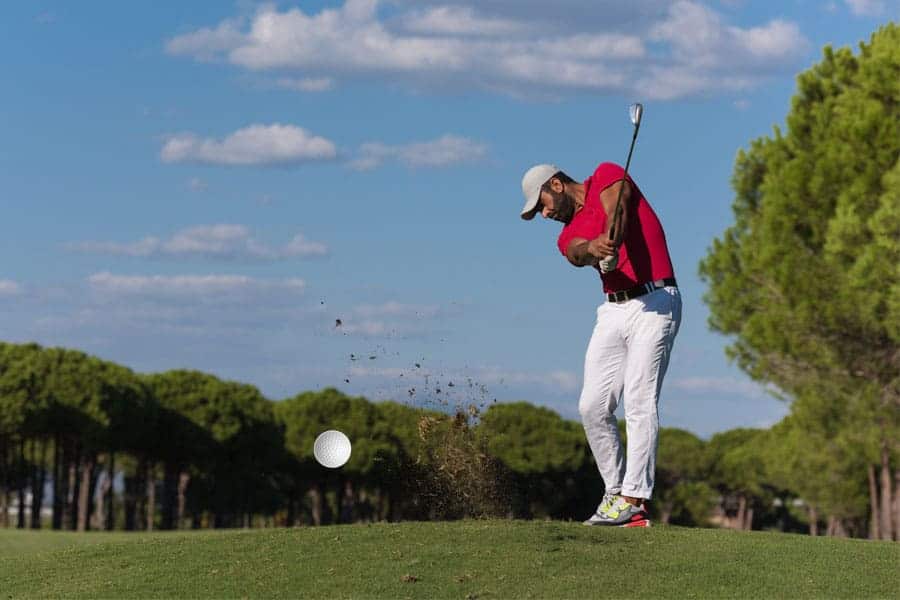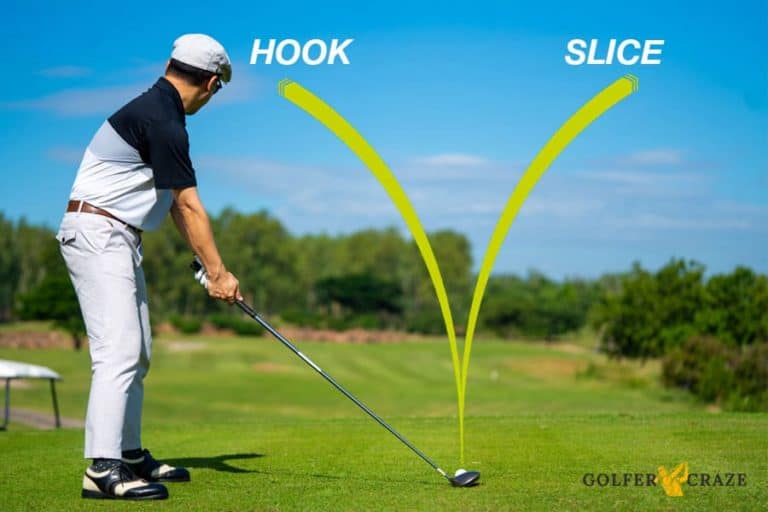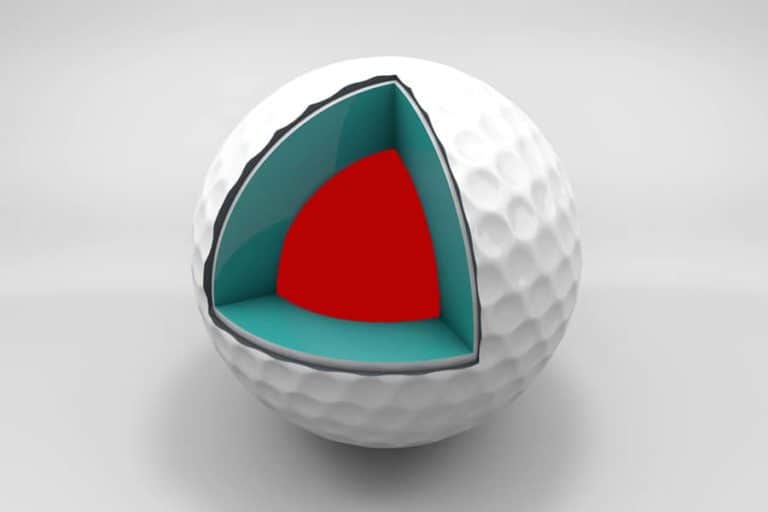How To Hit A Stinger Shot – Tiger Woods’ Popular Shot

A stinger is a type of shot in golf that is hit with a low, flying trajectory and is designed to travel a shorter distance than a full shot. Here is all you need to know about how to hit a stringer shot.
The stinger shot is one of the most interesting and popular shots that Tiger Woods invented in his game. His patented 2 iron stinger is one of the shots that has influenced golfers worldwide. However, the majestic stinger Tiger Woods unleashed during the 2018 Players Championship was a work of art.
Hitting a stinger is a great way to add more distance to your golf shot. To hit one successfully, you’ll need to ensure that your swing is long and smooth.
I. How to hit stinger shots?
To hit a stinger, follow these simple steps:
1) Proper setup
Setup plays an important role while hitting a stinger. First, begin by setting up the tee fully into the ground as placed for a normal iron shot.
2) Play the ball mid-forward
Move the ball position a little further back towards the center of the stance. This helps keep the body weight in balance such that you don’t move the weight to your forward foot, or you will hit it down too much.
3) Pull the club
The clubface must be behind your hands at impact to hit a stinger. To achieve this effect, pull the club through the swing and accelerate swiftly with your hips and hands for maximum power. The point of contact should push the golf ball forward rather than launch it up to generate added momentum.
4) Noodle arms
The stinger can feel unfamiliar at first, causing many players to tense up and hold the club too tight. This only decreases the power and increases blisters.
Instead of gripping tightly, pretend your arms are noodles instead; maintain a loose grip throughout the swing for better results. Furthermore, make sure you focus on making solid contact with the ball, as a stinger shot relies on a crisp, clean hit rather than brute force.
5) Swing left and low
As you initiate the left mid-downswing, draw your hands slightly to the left for a stronger descending action. Make sure that the clubhead is as straight as possible throughout impact, and then begin to slow your hands right after contact with the ball. The ideal follow-through would be at or below your lead shoulder, resulting in less rotation speed, which keeps the flight trajectory low.
However, To generate a successful low stinger, you must maintain a consistent swing tempo, steady body movement, and ensure the clubface is square at impact.
6) Practice consistently
Practice your stinger shot on the driving range to get a feel for the normal swing and learn how to control the distance and trajectory of the ball.
Overall, hitting a stinger requires a combination of precise ball-striking and shot-shaping skills. With some practice and patience, you can master this useful shot and add it to your arsenal on the course.
II. Points to remember while hitting a Stinger shot
- Position the ball towards the middle or slightly back of your stance.
- Slightly press the shaft forward to ensure your hands are ahead at impact, but only for iron shots. Avoid doing this with drivers.
- Stand with a slightly narrower stance, positioning yourself closer to the ball.
- Keep your shoulders open to the target, with the back shoulder nearer to the ball than the lead shoulder.
- Distribute your weight with 60% on the front foot and 40% on the back foot to encourage a downward angle of attack.
- Unlike a punch shot, aim for a full swing with maximum clubhead speed.
III. Did Tiger Woods introduce a new golf shot with his Stinger?
While the stinger shot may have gained popularity and recognition in recent years thanks to Tiger Woods, it is not a new golf shot.
In fact, it has been used by skilled players for decades, with some even referring to it as a “bump and run”, “chip and run” shot or “Knockdown” shot.
However, Tiger’s mastery of the stinger and its prominent use in high-pressure moments has certainly brought attention to the shot and solidified its place as a valuable tool in any golfer’s arsenal.
IV. Who should play this shot?
The stinger shot is not for everyone or all for all situations. It cannot be pulled off as easily as it seems.
For instance, if you are a beginner or high-handicap golfer, you need to first groove your swing before trying out this advanced shot. Unless you consistently break 85, you are not recommended to try this shot.
V. Why do people consider the Stinger a controlled golf shot?
People view the Stinger as a controlled golf shot because of how it affects the way the club hits the ball. To pull off a Stinger, golfers need to lean the club’s handle toward the target more than usual, giving them better control over the shot.
This technique also results in a lower trajectory, which helps players control the direction of the ball even more. However, it might not travel as far or stop as quickly as a regular shot.
One common mistake golfers make is closing the club’s toe too soon, causing the ball to hook off course. The Stinger helps prevent this by keeping the clubface open longer through impact, reducing the chance of a hook.
Overall, the Stinger’s unique mechanics give golfers more control over their shots, making it a popular choice on the course.
VI. When should you play the Stinger?
The stinger should be used in situations where you need to control the trajectory of your shot, such as managing windy conditions or navigating tight fairways. It is also useful when facing challenging weather conditions, such as headwinds, crosswinds, and tailwinds.
Additionally, it can be a strategic tool for bypassing hazards or positioning on difficult doglegs. As you become more comfortable with the shot, it can also be used in various scenarios to add variety and control to your game.
VII. What clubs to use while hitting stingers?
Most golfers try to hit stingers by using the longest iron, but, in fact, the angle of the clubface makes a lot of difference. Using a 5-iron is recommended as the descending blow required for a stinger changes the angle of the clubface at impact. Once you master hitting with 5 iron, you can move to 4 iron or 3 iron.
To execute a stinger, you can use your driver and potentially even a 3-fairway wood. Doing so ensures you have maximum control over your shot while allowing for an increased run on the fairway and green. Of course, you would be quite impressed if you attempted it with just a putter!
VIII. Common Mistakes to Avoid When Attempting the Stinger
• Overcompensation for Height: Sometimes, there’s a temptation to exert too much effort in keeping the ball low, but doing so can result in a choppy and insufficient swing. Instead, trust the adjustments you’ve made and focus on following through smoothly.
• Swing Speed: Don’t compromise swing speed for a lower shot. Ensure that the clubhead comes through with authority to avoid mis-hits and inconsistent shots.
IX. Tips and Drills
Let’s look at few practice Exercises to Improve your Stinger shot consistency:
• The Hanging Club Drill: When swinging a wedge with an extended shaft, ensure that the grip is directed towards your belt buckle as you come through the shot. This alignment aids in maintaining control. It also enhances precision throughout the swing.
• Low Tee Shots: To master the stinger shot, it’s important to adjust to the lower ball position and the specific trajectory it requires. One effective tip is to use low tees during practice sessions or even practice without a tee altogether. This gradual adjustment helps you develop a better sense of how to execute the shot effectively.
• Half Swing Drills: Focus on keeping the ball trajectory low and under control, without forcefully trying to add power to the shot. This approach helps you refine the technique and develop consistency in executing the stinger.
X. How is a stinger different from a punch shot?
A punch shot is played off the back of your stance and is meant to keep the ball lower. This is commonly used to avoid obstructions like trees.
But, in the case of a stinger, it is a full-swing lowball shot with lower ball flight and travels its full distance. This shot is used to find the center of the short stuff, not to avoid trees.
Conclusion
Stinger is a great shot to add power and accuracy to your golf game. With the right technique and a few simple steps, you can learn to hit this challenging golf shot with confidence.
Remember to keep your body balanced, use a strong grip, and keep the clubface square to the target. Make sure to generate power from your lower body and keep your arms and hands relaxed. Finally, focus on making a full, aggressive follow-through. With practice and patience, you can master the art of the stinger shot.
FAQ’s
1. How to hit a stinger draw?
To maximize the success of a Stinger Draw, set up with your feet aimed slightly rightward and close to the target while also positioning your ball further back than usual in your stance. As you make contact with the clubface, ensure that it remains closed throughout for ultimate performance.
2. How to hit a stinger fade?
The procedure is rather clear-cut: ball forward, pull the club back, swing your arms in an arc-like motion, and take a low leftward swing. The only distinction lies in slightly adjusting yourself to the left of the target before contact with the ball and opening up the face angle of your club upon impact. For alignment purposes, draw a line on which you should hit; this will result in delivering a strong fade shot.
3. Do I need to adjust my grip for the stinger?
Yes, you might need to make some adjustments to your grip when hitting a stinger shot.








